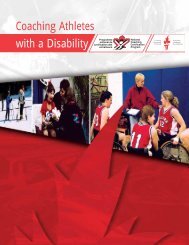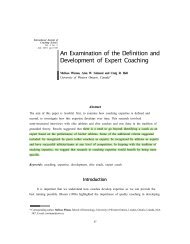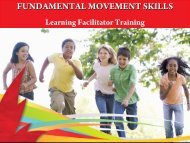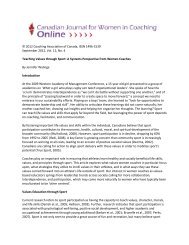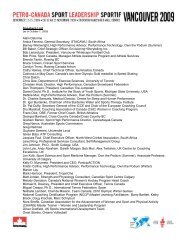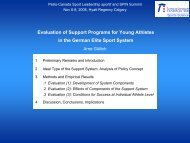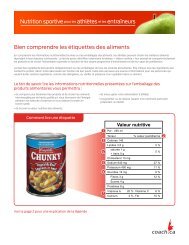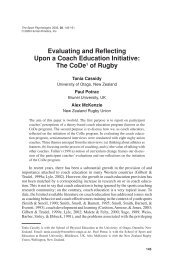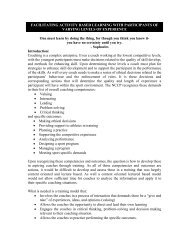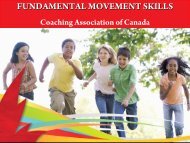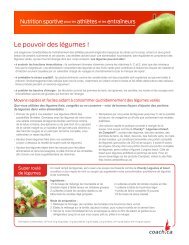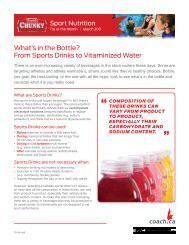LTAD NCCP Integration - Coaching Association of Canada
LTAD NCCP Integration - Coaching Association of Canada
LTAD NCCP Integration - Coaching Association of Canada
You also want an ePaper? Increase the reach of your titles
YUMPU automatically turns print PDFs into web optimized ePapers that Google loves.
Paradigm Shifts in Sport<br />
<strong>NCCP</strong> – <strong>LTAD</strong> <strong>Integration</strong><br />
Petro-<strong>Canada</strong> Sport Leadership Conference<br />
Istvan Balyi<br />
National <strong>Coaching</strong> Institute BC<br />
<strong>LTAD</strong> Advisor<br />
sportscoachUK, Republic <strong>of</strong> South Africa,<br />
Kingdom <strong>of</strong> Bahrain, Sport <strong>Canada</strong>
Paradigm Shifts in Sport<br />
• <strong>LTAD</strong><br />
– 10 key Factors<br />
– 10 S’s<br />
• Functional training<br />
– Pre-habilitation or<br />
Rehabilitation<br />
• The Myth <strong>of</strong> the Aerobic Base<br />
in Power Sports<br />
• Transfer <strong>of</strong> Strength<br />
• Speed Training All Year<br />
round<br />
• The Myth <strong>of</strong> Periodization <strong>of</strong><br />
Strength<br />
– Or endurance or speed, or<br />
skill or flexibility<br />
• Overtraining or underrecovery<br />
• Female Athletes and the<br />
Menstrual Cycle<br />
• Chrono or time<br />
– Chrono-nutrition<br />
– Chrono-hydration<br />
• Hygiene<br />
• Flexibility<br />
• Ancillary Capacities<br />
• Periodization<br />
– Junior periodization<br />
• The Diminishing Return<br />
Phase and the Elite Athlete<br />
• Taper
But what is a paradigm<br />
• Thomas Kuhn in his book “The Structure <strong>of</strong> Scientific<br />
Revolutions” (1996) describes paradigms as “the<br />
overall framework <strong>of</strong> basic assumptions used by<br />
scientists when they analyze and interpret their<br />
data.”<br />
• A paradigm can also be thought <strong>of</strong> as a pattern that is<br />
superimposed on the world in order to make sense <strong>of</strong><br />
it.
What is a Paradigm<br />
• When enough significant anomalies have accrued<br />
against a current paradigm, the scientific discipline<br />
is thrown into a state <strong>of</strong> crisis, according to Kuhn.<br />
• During this crisis, new ideas, perhaps ones<br />
previously discarded, are tried.<br />
• Eventually a new paradigm is formed, which gains<br />
its own new followers, and an intellectual "battle"<br />
takes place between the followers <strong>of</strong> the new<br />
paradigm and the hold-outs <strong>of</strong> the old paradigm.
What is a Paradigm<br />
• The approach to athletic training has undergone<br />
radical changes over the last decade.<br />
• These changes are sometimes referred to as<br />
paradigm shifts.<br />
• New paradigms for short and long-term athlete<br />
preparation, planning, and periodisation are<br />
challenging coaches and sport administrators to<br />
rethink and restructure training, competition and<br />
recovery.
What is a Paradigm<br />
• Coaches also use a framework <strong>of</strong> assumptions when<br />
they construct, implement and evaluate athletic<br />
training programs.<br />
• <strong>Coaching</strong> paradigms include assumptions about the<br />
nature <strong>of</strong> athletic training and competition.<br />
• Every coach has his/her paradigm <strong>of</strong> athletic<br />
preparation.
What is a Paradigm<br />
• Coaches <strong>of</strong>ten evaluate the value <strong>of</strong> their coaching<br />
paradigms based on athlete performance.<br />
• If a coaching paradigm has been successful in the<br />
past, there is a tendency for the coach to continue to<br />
use it.<br />
• However, history has shown that past success<br />
doesn’t guarantee future success.
« La définition de la folie, c’est refaire toujours la<br />
même chose en s’attendant à un résultat différent. »<br />
Albert Einstein<br />
“The definition <strong>of</strong> insanity is doing the same<br />
thing over and over again and expecting<br />
different results.”<br />
Albert Einstein
<strong>LTAD</strong> is<br />
• Optimal training, competition<br />
and recovery programming with<br />
relation to biological<br />
development and maturation<br />
• Equal opportunity for<br />
recreation and competition, it<br />
is not an elitist model
Seven<br />
Stages<br />
<strong>of</strong><br />
Long-Term<br />
Athlete<br />
Development<br />
Active Start<br />
FUNdamental<br />
Learning to Train<br />
Training to Train<br />
Training to Compete<br />
Training to Win<br />
Active for Life
<strong>LTAD</strong><br />
is the<br />
border collie<br />
<strong>of</strong><br />
sport system<br />
building !
A Framework for Activity
Cumann Lúthchleas L<br />
Gael – Builds Character
Contents<br />
Foreword<br />
Acknowledgements<br />
Introduction Learn to Train (Under 12)<br />
Strength Training<br />
Speed<br />
Aerobic Training<br />
Flexibility<br />
Mental Training<br />
Hydration and Nutrition<br />
Planning for Games<br />
Lets Go Games<br />
Games Skills Tactical Awareness<br />
Programmes for Development<br />
<strong>Coaching</strong> Skills<br />
Technical Development - Football<br />
Technical Development - Hurling<br />
Warm up<br />
Games for Better Team Play<br />
Code <strong>of</strong> Conduct<br />
Bibliography<br />
4<br />
5<br />
6<br />
21<br />
51<br />
61<br />
64<br />
70<br />
78<br />
84<br />
95<br />
106<br />
113<br />
137<br />
146<br />
197<br />
245<br />
266<br />
283<br />
289<br />
Istvan Balyi<br />
World leading expert on Long Term Player<br />
Development<br />
who described our Fundamentals manual as<br />
an example <strong>of</strong> good practice world wide
<strong>LTAD</strong><br />
• History <strong>of</strong> <strong>LTAD</strong> and a brief review <strong>of</strong> the literature<br />
• 10 Year Rule<br />
• The FUNdamentals - PL<br />
• Specialization<br />
• Developmental Age<br />
• Trainability<br />
• Mental, Cognitive and Emotional Development<br />
• Periodization<br />
• Calendar Planning for Competition<br />
• System Alignment and <strong>Integration</strong><br />
• Kaizen
<strong>Coaching</strong> <strong>LTAD</strong> Models<br />
A brief review
• <strong>LTAD</strong> is based on coaching science<br />
literature and NOT on the acquiring<br />
expertise literature<br />
• However, <strong>LTAD</strong> is supported by the<br />
acquiring expertise literature
Ericsson and Cote<br />
• Very interesting debate<br />
• Deliberate Practice<br />
• Deliberate Play<br />
• Sportscoach UK Athlete Development Pathway<br />
– Active Start<br />
– FUNdamental<br />
– Lear to Train = Learning to Play and Practice
Harsanyi, , (1985)<br />
• Reviewed long-term athlete development<br />
coaching models<br />
E<br />
Junior<br />
Juvenile<br />
Mass sport<br />
“Pyramid”<br />
T2W<br />
T2C<br />
T2T<br />
A4L<br />
L2T<br />
F<br />
AS
Harsanyi, , (1985)<br />
Classical models 1<br />
Usually based on 4 stage models<br />
– Child<br />
– Juvenile<br />
– Junior<br />
– Adult<br />
• Thiessen-<br />
Seibmann(1959)<br />
• Filin (1964)<br />
• Tscheiene (1970)<br />
• Hess (1971)<br />
• Feige (1978)<br />
• Frey (1980)<br />
• Basic<br />
• Intermediate<br />
• Advanced<br />
• Elite
Harsanyi, , (1985)<br />
Classical models 2<br />
• Age independent models<br />
– Martin (1977)<br />
– Nadori (1981)
Harsanyi, , (1985)<br />
Classical models 3<br />
• “Anti” early specialization models<br />
– Matveyev (1957)<br />
– Stemmler (1959)
Contemporary Models<br />
Long-term Structure <strong>of</strong> Training in Athletics<br />
(Thumm,, 1987)<br />
1. Basic training = over-all movement, many-sidedness, overall<br />
sports, rough structure <strong>of</strong> many or all athletic movement<br />
2. Build–Up training = Introduction <strong>of</strong> suitable competitive<br />
events, improvement <strong>of</strong> movement technique, rough<br />
differentiation into sprinting, middle and long distance events,<br />
throwing, jumping or multiple events<br />
3. Top-level training = Mastering <strong>of</strong> the technically finest form<br />
in changing situations, realization <strong>of</strong> conditional, coordination<br />
and psychological potential
Contemporary Models<br />
<strong>LTAD</strong> for Tennis (Holm, 1987)<br />
Four Stage Model<br />
• Pre-Competitive = 6 - 10 years<br />
• Overall = 11 - 14 years<br />
• Specific = 15 – 18 years<br />
• High<br />
Performance = 18+
Contemporary Models<br />
Biomotor Ability / Trainability (Holm, 1987)<br />
Ages: Boys Girls<br />
• Dexterity / Coordination 6 – 10 6 – 10<br />
• Flexibility 13 12<br />
• Speed Agility<br />
– Acceleration run 12 – 14 10 -12<br />
– Slalom run 13 11<br />
– Interval training 15 13<br />
• Strength<br />
– Stage 1 Neural Adaptations 10 – 14 10 – 12<br />
– Stage 2 Hypertrophy 15 – 16 13 – 15<br />
– Stage 3 Max Strength 17 – 18 16 – 17<br />
• Aerobic Capacity 12 - 14 11 – 13<br />
• Aerobic Power 17 – 18 16 - 17
Contemporary Models<br />
Long-term Structure <strong>of</strong> Training in Athletics<br />
(Thumm,, 1987)<br />
• Three stage model Duration years Age<br />
• 1 Basic training 4 - 5 9 – 14<br />
• 2 Build –Up training 3 – 4 15 – 18<br />
• 3 Top-level training 6 – 10 19 +
Contemporary Models<br />
Sanderson (1989)<br />
• Duration Developmental stage<br />
• Initiation 3-4 years Early school years<br />
• Basic training 5-7 Pre-puberty & puberty<br />
• Build up training 3-4 Post puberty<br />
• Systematic<br />
high level training 6-10+ Adulthood<br />
Sanderson U <strong>of</strong> S – reflected on developmental age, and<br />
was part <strong>of</strong> his model
Contemporary Models<br />
Multi Year Planning for Rugby (King, 1992)<br />
• Stage Age Training Age Training Phase<br />
• 1 12 - 13 1 - 2 Preliminary<br />
• 2 14 - 15 3 - 4 Basic Specialization<br />
• 3 16 - 17 5 - 6 Specialization<br />
• 4 18 - 19 7 - 8 Advanced Specialization<br />
• 5 20 - 21 9 - 10 Phase <strong>of</strong> Perfection<br />
• 6 22+ 11 High Performance
Contemporary coaching models<br />
Touretski (1993)<br />
AIS Swimming<br />
• Stage 1 - Preliminary preparation 7-9 (f) 8-10 (m)<br />
• Stage 2 - Initial sport-specific prep 9-10 (f) 10-11 (m)<br />
• Stage 3 – In-depth specialization 12-14 (f) 13-15 (m)<br />
• Stage 4 – Sporting perfection 15-16 (F0 16-19 (m)<br />
(lasts 2 to 8 years)
Contemporary Models<br />
Belov (1995)<br />
Soviet Gymnastics<br />
• Stages<br />
– Initial<br />
– Intermediate<br />
– Final<br />
• Sub-stages<br />
– General preparation<br />
– Initial technical preparation<br />
– Specialized perfection<br />
– Elite (high performance)<br />
– Retirement
• Four stage model:<br />
Contemporary Models<br />
Bompa, 1995<br />
1. Initiation 6 - 10<br />
2. Athletic formation 11 - 14<br />
3. Specialization 15 - 18<br />
4. High performance 19 +
Four Stages Model
Stages <strong>of</strong> Training and Puberty
Platonov (1985) A Five Stage Model<br />
Stages General<br />
Training Load<br />
Complementary<br />
Training Load<br />
Specific<br />
Training Load<br />
Annual<br />
Training Load<br />
(in hours)<br />
Initial 50 45 5 100-250<br />
Basic 35 50 15 350-500<br />
Specific<br />
Base<br />
20 40 40 600-800<br />
Maximization 15 25 60 900-1100<br />
Maintenance 10 25 65 1200-1400
<strong>LTAD</strong> 1<br />
• F. Dick 1985 – periodization article<br />
–Train to Train<br />
–Train to Compete
<strong>LTAD</strong> 2, BC Tennis<br />
•T2T<br />
•T2C<br />
•T2W
<strong>LTAD</strong> 3, BC Tennis<br />
• Early and Late Specialization sports are<br />
distinguished – introduction <strong>of</strong> the<br />
FUNdamental stage<br />
•FUNdamentals<br />
•T2T<br />
•T2C<br />
•T2W
<strong>LTAD</strong> 4 BC<br />
• FUNdamentals 6 – 10 years<br />
•T2T<br />
•T2C<br />
•T2W<br />
• Retirement / Retainment
<strong>LTAD</strong> 5<br />
Research on Physical Literacy and Skill Acquisition<br />
“skill hungry years” or “the golden age <strong>of</strong> skill learning”<br />
• FUNdamentals 6 – 8 F and 6 – 9 M<br />
• Learning to Train 8 – 11 F and 9-12 M<br />
• T2T 11 – 15 F and 12 – 15 M<br />
•T2C<br />
•T2W<br />
• Retirement / Retainment
<strong>LTAD</strong> 6<br />
•Active start<br />
• Active for Life
<strong>LTAD</strong> 6<br />
•Active Start<br />
•FUNdamentals<br />
•L2T<br />
•T2T<br />
•T2C<br />
•T2W<br />
• Active for Life
<strong>LTAD</strong> 6<br />
• Variations<br />
– Terminology (Diving, Triathlon)<br />
– Number <strong>of</strong> stages ( L2C, L2W, Winning for a<br />
Living, etc.)
<strong>LTAD</strong> a Paradigm Shift in Sport<br />
• <strong>Coaching</strong> athletes on developmental age<br />
• Finding solutions for “relative age”<br />
• Training programs are designed on biological markers<br />
• The sensitive periods <strong>of</strong> accelerated adaptation to<br />
training is utilized<br />
• Exclusion to inclusion
FUN …Adapt and Modify Games - GO GAMES<br />
Go Hurling<br />
Go Gaelic<br />
<strong>LTAD</strong><br />
FUNdamentals<br />
( 6 To 8 yrs.)<br />
Learn TO Play 1<br />
(8 To 10 yrs.)<br />
Learn to Play 2<br />
(10 To 12 yrs.)
Traditional Games V Go Games: The Advantages<br />
Turn more on than Off<br />
Traditional Model<br />
Full Games<br />
Full Rules<br />
Go-Games Model<br />
Conditioned Game<br />
Modified Game<br />
‘Outcome’ Focused<br />
‘Processed’ Focused<br />
Substitutions<br />
Everyone Plays<br />
Dominated Better Players All ability levels<br />
Less Skilled Discarded Special Needs<br />
Parent/Mentor Pressures Non-Threatening<br />
Too much competition can<br />
limit early development<br />
Turn them onto Sport<br />
Fun, Fair Play, and<br />
Full Enjoyment will
FUN ….GO GAMES v 15 a Side…The Evidence<br />
Turn more OFF than ON<br />
Traditional Model<br />
Little Ball to Player Contact – Little Action<br />
Turn more ON than OFF<br />
Go-Games Model<br />
More Ball to Player Contact – More Action<br />
Ball and Player out <strong>of</strong> range – Ball and Player in range at all times -<br />
Little Interest and Boredom<br />
More concentration – More Fun<br />
Ratio 15 a side 1: 29 Ratio 7 a side 1:6<br />
More numbers – difficult decision making Less numbers – easier decision<br />
leading to beehive football and hurling making and Better Team Play<br />
Bigger Space – Greater Scanning ability Less Space – Less scanning<br />
- Player needs to use it. Better Spatial Awareness
• Physical Literacy<br />
• A hierarchy, level and number <strong>of</strong> competitions are<br />
designed for all stages (taking into consideration<br />
limitations <strong>of</strong> capabilities before, during and after<br />
puberty<br />
• Random to planned change<br />
• System alignment and integration<br />
– Provincial level<br />
– Federal level<br />
• Kaizen
10 S’s S s <strong>of</strong> <strong>LTAD</strong><br />
• The Original 5 S’s<br />
– Stamina<br />
– Strength<br />
– Speed<br />
– Skill<br />
– Suppleness<br />
– (Trainability)<br />
• The Additional 5 S’s<br />
– Structure/Stature<br />
– (p)Sychology<br />
– Sustenance<br />
– Schooling<br />
– Socio-Cultural
Trainability<br />
• Speed, Skill and Suppleness is based on<br />
Chronological Age<br />
• Stamina and Strength are based on Developmental<br />
Age<br />
• Biological markers for Developmental Age:<br />
– Onset <strong>of</strong> the PHV or Growth Spurt<br />
– PHV (after growth decelerates)<br />
– Onset <strong>of</strong> Menarche
Structure / Stature<br />
Kinanthropometry<br />
(Ross, 2008)<br />
A scientific specialization for human biology and the health pr<strong>of</strong>essions<br />
Identification<br />
Specification<br />
Application<br />
Relevance<br />
Kinanthropometry<br />
for study <strong>of</strong> :<br />
to understand:<br />
Implications for:<br />
movement<br />
Size<br />
Shape<br />
Growth<br />
Exercise<br />
Health<br />
Education<br />
human<br />
Proportion<br />
Composition<br />
Performance<br />
Nutrition<br />
Government<br />
Commerce<br />
measurement<br />
Maturation<br />
Gross<br />
Function<br />
Aim: 1) optimal growth and development <strong>of</strong><br />
all the children <strong>of</strong> all the people 2) health and<br />
vigor <strong>of</strong> adults throughout their life span
www.ltad.ca<br />
Later this year
Age 13 14 13 14
Forthcoming:<br />
Mental Skills for <strong>LTAD</strong> Stages<br />
www.ltad.ca
Operationalizing <strong>LTAD</strong><br />
• Competition Reviews<br />
– Rowing<br />
– Speed Skating<br />
– Rugby<br />
– XCountry skiing<br />
– Swimming<br />
• Athletics<br />
– Annual periodized plans for the T2T, L2C and T2C stages<br />
• Sprints and hurdles<br />
• Distance<br />
• Jumps<br />
• Throws<br />
• Multiple events<br />
• Curling
COMPETITION PLAN FOR CURLING<br />
TWO GAME DAY #1: 8:00 a.m. & 2:30 p.m.<br />
Wake-up<br />
Light aerobic<br />
stretching<br />
Breakfast<br />
Hydrate<br />
Snack<br />
Debrief<br />
Reload<br />
Mental Recovery<br />
Lunch<br />
Napping<br />
Less than<br />
30 mins.<br />
Hydrate<br />
Snack<br />
Mental Recovery<br />
Debrief<br />
Reload<br />
Supper<br />
Relax<br />
Reset<br />
Sleep<br />
5 6 7 8 9 10 11 12 1 2 3 4 5 6 7 8 9 10 11 12<br />
GAME 1 GAME 2<br />
Pre-Competition Routine:<br />
Warm up<br />
Psychological prep.<br />
Hydrate and Snack<br />
Post-Comp. Routine<br />
Cool down<br />
Rehab/ Recovery/Ice<br />
Light Stretch Snack<br />
Recommend leaving<br />
the building<br />
Pre-Competition<br />
Routine:<br />
Warm up<br />
Psychological prep.<br />
Post-Comp. Routine<br />
Cool down<br />
Rehab/ Recovery/Ice<br />
Light Stretch Snack<br />
Can watch 30 min.<br />
Notes:<br />
Snack (reload) within 20 minutes <strong>of</strong> end <strong>of</strong> each Game<br />
Even if you are going for dinner<br />
Dagg-Jackson; Way; Balyi; Comartin;<br />
Parsons; Cox; Farres; 2005
COMPETITION PLAN FOR CURLING<br />
TWO GAME DAY #2: 9:00 a.m. & 7:00 p.m.<br />
Wake-up<br />
Light aerobic<br />
stretching<br />
Breakfast<br />
Hydrate<br />
Snack<br />
Debrief<br />
Reload<br />
Lunch<br />
Mental Recovery<br />
Napping<br />
30 mins.<br />
Wake-up<br />
Light aerobic<br />
Stretching<br />
Go for walk<br />
Supper<br />
Mental Recovery<br />
Debrief<br />
Reload<br />
Hydrate<br />
Snack<br />
Relax<br />
Reset<br />
Sleep<br />
5 6 7 8 9 10 11 12 1 2 3 4 5 6 7 8 9 10 11 12<br />
GAME 1 GAME 2<br />
Pre-Competition Routine:<br />
Warm up<br />
Psychological prep.<br />
Hydrate and Snack<br />
Post-Comp. Routine<br />
Cool down<br />
Rehab/ Recovery/Ice<br />
Light Stretch Snack<br />
Recommend leaving<br />
the building<br />
Pre-Competition<br />
Routine:<br />
Warm up<br />
Psychological prep.<br />
Post-Comp. Routine<br />
Cool down<br />
Rehab/ Recovery/Ice<br />
Light Stretch Snack<br />
Can watch 30 min.<br />
Notes:<br />
Snack (reload) within 20 minutes <strong>of</strong> end <strong>of</strong> each Game<br />
Even if you are going for dinner<br />
Dagg-Jackson; Way; Balyi; Comartin;<br />
Parsons; Cox; Farres; 2005
COMPETITION PLAN FOR CURLING<br />
3 GAME DAY #1 – 9 am; 4 pm; 8 pm<br />
Wake-up<br />
Light aerobic<br />
stretching<br />
Breakfast<br />
Hydrate<br />
Snack<br />
Debrief<br />
Reload<br />
Mental Recovery<br />
Lunch<br />
Napping<br />
30 minutes<br />
Hydrate<br />
Snack<br />
Mental Recovery<br />
Debrief<br />
Reload<br />
Bigger<br />
Snack<br />
Disengagement<br />
Mental cool-down<br />
Sleep<br />
5 6 7 8 9 10 11 12 1 2 3 4 5 6 7 8 9 10 11 12<br />
GAME 1<br />
GAME 2 GAME 3<br />
Pre-Competition Routine:<br />
Warm up<br />
Psychological prep.<br />
Hydrate and Snack<br />
Post-Comp. Routine<br />
Cool down<br />
Rehab/ Recovery/Ice<br />
Light Stretch Snack<br />
Leave the building<br />
Pre-Competition Routine:<br />
Warm up<br />
Psychological prep.<br />
Post-Comp. Routine<br />
Cool down<br />
Rehab/ Recovery/Ice<br />
Light Stretch<br />
Bigger Snack<br />
Notes:<br />
• If the Game is short modify times.<br />
• If the Game goes into extra end again<br />
modifications need to be made.<br />
Abbreviated<br />
Post-Comp. Routine<br />
Cool down<br />
Rehab/ Recovery/Ice<br />
Light Stretch/Snack<br />
Dagg-Jackson; Way; Balyi; Comartin;<br />
Parsons; Cox; Farres; 2005
COMPETITION PLAN FOR CURLING<br />
3 GAME DAY #2 – 8 am; 11:30 pm; 3 pm<br />
Wake-up<br />
Light aerobic<br />
stretching<br />
Debrief<br />
Reload<br />
Mental Recovery<br />
Debrief<br />
Reload<br />
Mental Recovery<br />
Breakfast<br />
Hydrate and snack throughout day - games and breaks<br />
Meal<br />
Travel or Sleep<br />
5 6 7 8 9 10 11 12 1 2 3 4 5 6 7 8 9 10 11 12<br />
GAME 1 GAME 2 GAME 3<br />
Modified<br />
Pre-Competition Routine:<br />
Warm up<br />
Psychological prep.<br />
Hydrate and Snack<br />
Post-Comp. Routine<br />
Cool down<br />
Rehab/ Recovery/Ice<br />
Light Stretch Snack<br />
Leave the building<br />
Post-Comp. Routine<br />
Cool down<br />
Rehab/ Recovery/Ice<br />
Light Stretch/Snack<br />
Notes:<br />
• If the Game is short modify times.<br />
• If the Game goes into extra end again<br />
modifications need to be made.<br />
• Benefits <strong>of</strong> fitness enable coping with this schedule<br />
• Meal evening before is essential<br />
Dagg-Jackson; Way; Balyi; Comartin;<br />
Parsons; Cox; Farres; 2005
<strong>NCCP</strong> and <strong>LTAD</strong> Alignment<br />
• <strong>LTAD</strong> is content<br />
• Not only the stages but the 10 Key Factors and the<br />
10 S’s<br />
• GAA example <strong>of</strong> full integration <strong>of</strong> <strong>LTAD</strong> and<br />
<strong>Coaching</strong> education<br />
• Taekwondo integration
Long-Term Athlete Development<br />
C. Flett, Director, <strong>NCCP</strong>
Performance<br />
Oriented<br />
Athletes/Teams<br />
Participation<br />
Oriented<br />
Sportspeople<br />
Talents<br />
High<br />
Performance<br />
Beginners<br />
Participation<br />
Oriented<br />
7<br />
Master Coach<br />
EQF<br />
Levels<br />
(1- 8)<br />
-<br />
Senior Coach<br />
Coach<br />
National<br />
Levels<br />
3<br />
Apprentice Coach
Draft Long Term Participant Development Pathway<br />
Participation-Oriented<br />
Performance-Oriented<br />
LEARNING &<br />
RE-LEARNING<br />
TO PARTICIPATE<br />
Sustaining<br />
Participation<br />
Developing<br />
Participation<br />
Sustaining<br />
Performance<br />
Developing<br />
Performance Podium<br />
Development<br />
Talent<br />
Talent Development<br />
LEARNING TO PLAY AND PRACTICE<br />
EARLY<br />
SPEC.<br />
FUNDAMENTALS<br />
SPORTS<br />
ACTIVE START
Long Term Coach Development Model
Questions
Definitions<br />
• Growth refers to observable step-by-step changes in<br />
quantity, “measurable changes in body size, for<br />
example, height, weight, fatness.” (Malina, 1986)<br />
• Maturation refers to “qualitative system changes,<br />
both structural and functional in nature, in the<br />
organism’s progress toward maturity, for example,<br />
the change <strong>of</strong> cartilage to bone in the skeleton.”<br />
(Tihanyi, 1990)
• Development refers to “the<br />
interrelationship between growth<br />
and maturation in relation to the<br />
passage <strong>of</strong> time.<br />
• The concept <strong>of</strong> development also<br />
includes the social, emotional,<br />
intellectual and motor realms <strong>of</strong> the<br />
child.” (Tihanyi, 1990)
• Chronological age refers to “the number <strong>of</strong><br />
years and days elapsed since birth” (Haywood,<br />
1993)<br />
• Skeletal age refers to the maturity <strong>of</strong> the<br />
skeleton “determined by the degree <strong>of</strong><br />
ossification <strong>of</strong> the bone structure.” (Haywood,<br />
1993)
• Critical periods <strong>of</strong> development: A<br />
critical period refers to a point in the<br />
development <strong>of</strong> a specific behaviour when<br />
experience or training has an optimal<br />
effect on development. The same<br />
experience, introduced at an earlier or<br />
later time, has no effect on, or retards<br />
later skill acquisition. (Zaichkowsky,<br />
Zaichowsky and Martinek, 1980)
Trainability<br />
• Malina and Bouchard (1991) defined<br />
trainability as “the responsiveness <strong>of</strong><br />
developing individuals at different stages<br />
<strong>of</strong> growth and maturation to the training<br />
stimulus.”.
• Malina and Bouchard (1991) also referred to<br />
“readiness and critical periods” <strong>of</strong> trainability during<br />
growth and development <strong>of</strong> young athletes, thus the<br />
stimulus have to be timed<br />
to achieve optimum adaptation with regard to motor<br />
skills, muscular and/or aerobic power .
• Adaptation refers to a stimuli or a series <strong>of</strong><br />
stimuli which induces functional and/or<br />
morphological changes in the organism.<br />
Naturally, the level or degree <strong>of</strong> adaptation<br />
is dependent on the genetical endowment <strong>of</strong><br />
an individual. However, the general trends or<br />
patterns <strong>of</strong> adaptation are identified by<br />
physiological research and the facts and<br />
guidelines <strong>of</strong> the different adaptation<br />
processes, such as adaptation to muscular<br />
endurance or maximum strength, are clearly<br />
delineated.<br />
• Diagnostics before and after maturation<br />
• Moving scales during PHV



